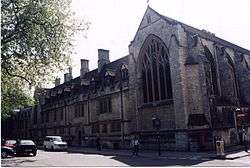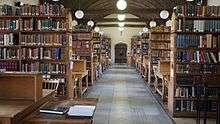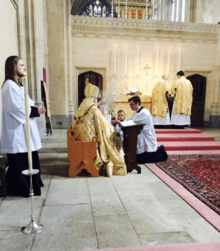Pusey House, Oxford
Pusey House is an Anglican religious institution located in St Giles', Oxford, immediately to the south of Pusey Street. It is firmly rooted in the Anglo-Catholic tradition of the Church of England. Known as a "House of Piety and Learning", it is associated with, but is not part of, the University of Oxford.

History

Pusey House was opened on 9 October 1884[1] in part as a memorial to Edward Bouverie Pusey, Regius Professor of Hebrew at Oxford University, a canon of Christ Church Cathedral and for 40 years, a leading figure in the Oxford Movement, a movement of the mid-19th century which sought to bring the Church of England to a deeper understanding of its witness as part of the universal (aka 'catholic') Church.[2] It was also intended to continue the work of Pusey in restoring the Church of England's Catholic life and witness.[3] It was established with a fund of £50,000 to provide a building for Pusey's library, purchase it and create an endowment so that two or more clergy could take charge of it and promote religious life in the university.[4][5] The first principal was Charles Gore; Vincent Stuckey Coles was principal from 1897 to 1909. The next principal was Darwell Stone.[6] Pusey House celebrated its 125th anniversary of foundation on 31 October 2009, with a Solemn High Mass at which the preacher was Robin Ward, Principal of St Stephen's House.[7] Since 1981 a large part of the original Pusey House site has been occupied by St Cross College.[8]
Buildings
The perpendicular Gothic buildings were designed by the architect Temple Moore, with some additions made by his son Leslie Moore in the early 1920s.[9] Replacing domestic houses and a wooden chapel, the work was financed by a large bequest from Leeds solicitor J.W. Cudworth.[10]
The chapel was completed in 1914, and furnished during the 1930s to designs by Ninian Comper including a gilded baldacchino.[9] Some of Comper's original vestments remain in use and others have been commissioned using his original designs. The chapel remains a place of worship where the offices are chanted and the Mass offered every day; either quietly in the stillness of an early weekday morning or with music and full ceremonial on Sundays.
Library

The library is a theological and historical collection of 75,000 volumes which includes Pusey's library and a large collection of other theological and historical volumes. Pusey's own books, bought after his death, originally formed the heart of Pusey House Library. Since then, by gift and purchase, the library has grown into an important collection that has been recognised by The National Archives as a leading specialist library not only in Oxford but in the United Kingdom. In addition to its primary source material and books on the Anglo-Catholic Movement (Tractarian and Oxford Movements), the library also has good collections of material for the study of Patristics, Church history, liturgy, doctrine, monasticism and Anglican Catholic organisations.[11]
The archive contains extensive material on the Tractarians and the Oxford Movement: the records of a number of Anglo-Catholic societies; communities of monks and nuns; letters and papers of notable Anglicans, as well as the archive of Pusey himself.[12]
The manuscripts include papers of many important figures, organisations and societies connected with the Oxford Movement in the 19th and 20th centuries. The most significant holdings are those of E. B. Pusey, H. P. Liddon, and S. L. Ollard, but there are also papers relating to such notable people as William Ewart Gladstone, John Henry Newman, Canon "Freddie" Hood, F. L. Cross, and John Keble.[13]
Worship
Worship in the Chapel of the Resurrection is in accordance with the Anglo-Catholic tradition in the Church of England and is open to all, especially to members of the university.[14] Alongside its reputation for dignified and traditional liturgy, Pusey House is also recognised for its musical tradition, most visible at the Solemn Mass on Sundays and solemnities.[15] The choir's extensive repertoire ranges from the earliest church music and Gregorian chant, through the polyphony of Byrd and extending to 19th and 20th century composers such as Vierne and Stanford. Pusey House commissioned a new Mass-setting for its 125th anniversary celebrations from the composer Alexander Campkin.
Services and observances
- Solemn High Mass every Sunday and on major festivals during full term with the Ordinary of the Mass sung by the choir
- Morning Prayer and Evening Prayer, daily during full term
- Compline each Tuesday evening during full term
- Low Mass daily during full term, with a BCP celebration on Saturdays
- Traditional devotions including Stations of the Cross in Lent and Benediction of the Blessed Sacrament
- Holy Week retreat at Ascot Priory in Berkshire.[16]
Teaching and pastoral care
- Counsel and instruction in the catholic faith
- Preparation for the sacraments
- Sacramental confession
- Formation of vocations to the sacred priesthood
- Visiting preachers and academics
- Pilgrimage to the Anglican Shrine of Our Lady of Walsingham
- Residential reading week at the Abbey of Bec in Normandy
Friends organisation

The Friends of Pusey House organisation exists to provide additional support for its work and witness, both in England and abroad, by their prayers and by informing others about Pusey House.[17]
Principals
- 1884-1893: Charles Gore
- 1893-1897: Robert Lawrence Ottley
- 1897-1909: Vincent Stuckey Stratton Coles
- 1909-1934: Darwell Stone
- 1934-1951: Archibald Frederic Hood
- 1951-1970: Francis Hugh Maycock[18]
- 1970: Barry Marshall (died before installation)
- 1970-1981: Cheslyn Peter Montague Jones
- 1982-2002: Philip Ursell
- 2003-2013: Jonathan Baker
- 2013- : George Westhaver[19]
Priest-Librarians (Incomplete)
- 1884-1897 VSS Coles
- 1884-? F. E. Brightman*
- 1895-1908 H.F.B. Mackay
- 1908-1919 Darwell Stone*
- 1921-1924 Mark Carpenter-Garnier
- 1922-1923 Maurice Child
- 1927-1944 F.L. Cross*
- 1929-1937 Humphry Beevor
- 1941-1946 Eric Kemp*
- 1935-1952 Tom Parker*
- 195?-1955 Barry Marshall
- 1952-1957 Cheslyn Jones*
- 1957-1961 Robert Catling*
- 1960-1969 Donald Allchin
- 1961-1965 Rodney Hunter[20]
- 1968-1971 & 1976-1978 Peter Cobb[21]
- 1983-1994 Harry Smythe[22][6]
Those marked with an asterisk acted as Library Custodian.
References
- Pall Mall Gazette, Th ursday 18 September 1884, p.10
- "What is Pusey House?". Pusey House. Retrieved 15 July 2019.
- "The Times Digital Archive - Document". gdc.galegroup.com. Retrieved 16 July 2019.
- Alden's Oxford Guide, Oxford: Alden & Co., 1958; p. 101
- Henry Parry Liddon described its purpose thus: "A home of sacred learning and rallying-point for Christian faith ... It will form a centre of moral and intellectual and spiritual enthusiasm, in which all that is solid in inquiry and learning, and all that is lofty and aspiring in moral effort shall find encouragement under the consecrating shadow of a great name."--quoted in Alden (1958)
- Orford, Barry A. Davage, William. (2002). Piety and learning : the principals of Pusey House 1884-2002. Pusey House. OCLC 51228277.CS1 maint: multiple names: authors list (link)
- "Pusey House : News". web.archive.org. 20 April 2009. Retrieved 15 July 2019.
- "The move to St Giles". St Cross College. 1 August 2012. Retrieved 15 July 2019.
- Pevsner, Nikolaus, 1902-1983. (2002). Oxfordshire. Yale University Press. pp. 315–316. ISBN 0300096399. OCLC 896000965.CS1 maint: multiple names: authors list (link)
- Lepine, Ayla (2 April 2016). "Modern Gothic and the House of God: Revivalism and Monasticism in Two Twentieth-Century Anglican Chapels". Visual Resources. 32 (1–2): 76–101. doi:10.1080/01973762.2016.1132146. ISSN 0197-3762.
- "Printed Books". Pusey House. Retrieved 15 July 2019.
- "Archive". Pusey House. Retrieved 15 July 2019.
- "Pusey House Archive Catalogue". Retrieved 15 July 2019.
- "The House". Pusey House. Retrieved 16 July 2019.
- "THE MUSIC". Pusey House. Retrieved 16 July 2019.
- "The Chapel". Pusey House. Retrieved 16 July 2019.
- "Friends of Pusey". Pusey House. Retrieved 7 June 2019.
- "A Field Guide to the English Clergy' Butler-Gallie, F pp56-59: London, Oneworld Publications, 2018 ISBN 9781786074416
- "The Principals". Pusey House. Retrieved 19 September 2015.
- "The Times Digital Archive - Document". gdc.galegroup.com. Retrieved 16 July 2019.
- "OBITUARY: CANON PETER GEORGE COBB". www.churchtimes.co.uk. Retrieved 16 July 2019.
- "THE REVD DR HARRY REYNOLDS SMYTHE". www.churchtimes.co.uk. Retrieved 16 July 2019.
Further reading
Lepine, A. (2016). Modern Gothic and the House of God: Revivalism and Monasticism in Two Twentieth-Century Anglican Chapels. Visual Resources, 32(1-2), 1-26.
Orford, Barry A., Davage, William, and Ursell, Philip. Piety and Learning : The Principals of Pusey House 1884-2002 : Essays Presented to The Revd Philip Ursell. Oxford: Pusey House, 2002.
"The Pusey Memorial At Oxford." Times, 26 June 1885, p. 12. The Times Digital Archive, http://tinyurl.galegroup.com/tinyurl/BMsSi5. Accessed 16 July 2019.
External links